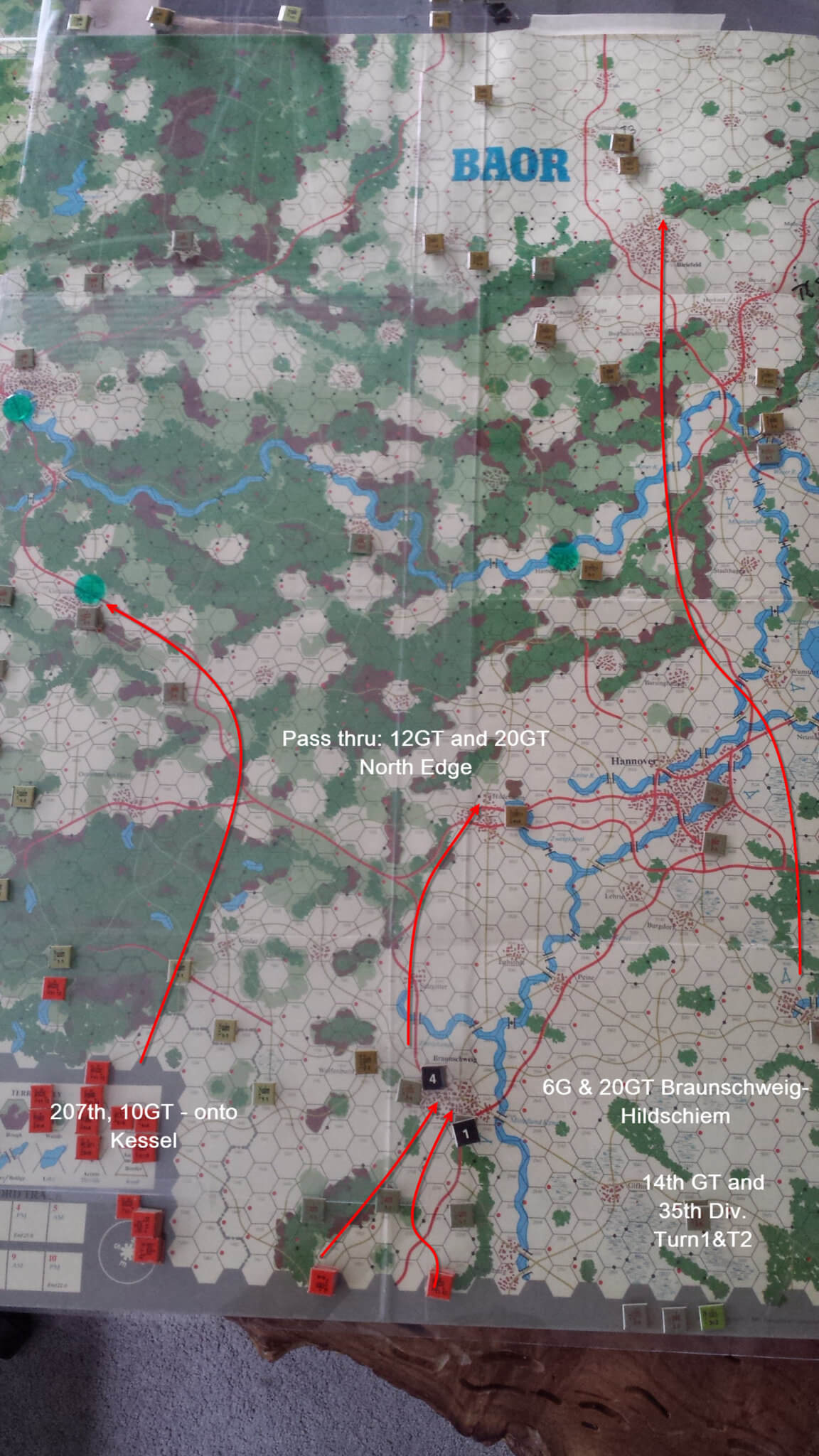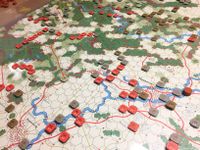Hello there people! Whats up?
Matt Irsik writes a fantastic review and game play AAR for all of us. Matt is a BGG member and agreed to let us see his handy work. An interesting discussion about the game is also available on the BGG site here.
Overview
BAOR, or British Army of the Rhine, was the third installment in SPI’s Central Front series, coming after Fifth Corps and Hof Gap. This was the game in Strategy & Tactics #88 and it could be linked to the other games in the series to depict a Soviet/Warsaw Pact thrust into West Germany. At a scale of 4km to the hex and most units being battalions for NATO and regiments for the Warsaw Pact forces, the Central Front series was definitely an operational level treatment of modern warfare. This game featured the NATO forces of the UK, Germany, and Belgium trying to hold the line along the Weser River while the Soviet forces tried to breach the river and move deeper into West Germany. The game came out at a time when WW3 was one of the driving forces in the hobby, with plenty of games coming out each year and an interested audience. After playing this game back in the 80s several times I reacquired it recently and decided to give it another look after having not played the series in quite some time.
Components
As with everything S&T in the 80s you got the standard 22 x 34 map, a few sheets of counters, 8-12 pages of rules, and a series of magazine articles dealing with the subject featured with the game. BAOR was definitely one of the more colorful maps and mates with the Fifth Corps map for even larger games. The map was typical of SPI during this time, with familiar hex symbols and graphics used in many of their games with one major difference; the use of “access points” on many of the hexes. This basically simulates the hundreds of small roads that inundate the German countryside without having to put line after line of roads all over the map. The counters are again standard fare for SPI at this time with the combat units showing attack and defense strength, with red for the Soviets, brown for the UK, gray for the West Germans, and a lighter tan for the Belgians. The remaining counters are used for the friction point system, of which there are quite a few. Overall, the map and counters are functional, but only slightly better than your average S&T game.
There are the series rules and the exclusive rules for each game in the series. The series rules are in the standard SPI case format and are actually fairly easy to get into, even though the subject and your first reading might indicate otherwise. The concepts , especially the friction point system, seem complex, but in practice works pretty well and the system can be taught quickly to others. The exclusive rules for this game are very short, consisting of the order of battle, a few changes to the first few turns, and two scenarios; Race to the Weser which is only a few turns long and The Thin Red Line, which is the full ten turn campaign. What is definitely missing in the components are bridge destruction and out of supply markers plus a track for victory points, EW warfare, and airpower. I’m sure it was the limit on components for a magazine game, but these things could definitely have made the game better.
Game System
While many concepts in BAOR will be familiar to most gamers such as combat, air support, zones of control, etc., there are some that will be new, which are operations and friction points. There are no movement allowances on the counters because each unit or stack of units gets to expend 12 operations points each turn. Operations points are used to move through various terrain, launch attacks, and to exit zones of control. For example, a Soviet motorized rifle regiment in one turn might move into woods (3 points), move 4 hexes on a road (2 points), cross two access points (2 points), and finally launch one march attack (2 points) followed by one hasty attack (3 points). Each time a unit moves it uses a friction point and each unit has a reverse side which counts as one friction point. When artillery fires and units take losses, it is in terms of friction points. When a unit exceeds its limit on friction points (most battalions are 5 and Soviet regiments are 6) it is destroyed. At the start of each turn each unit can remove one friction point (artillery removes 2), which usually is done by flipping the unit counter back over to its original side. If a unit has 3-4 Fps on it, there are some decisions to be made about pulling it out of the line for rest or continue in the attack/defense where there’s a good chance it will be eliminated.
This is the heart of the game and figuring out how to balance your use of friction points is critical to the success of the defense or the Soviet offensive in BAOR. This system does a very good job of simulating units fighting themselves to exhaustion, being pulled out of the line, then fresh units carry the momentum of the attack. With the option of taking friction point combat results as losses or retreating in hexes (or a combo) there are plenty of decisions about how far to push your units. If you need a West German battalion to hold a vital crossroads, then it might take a combat result entirely in friction points with the result that it will probably be eliminated the following turn or will need to be withdrawn from the front lines for several turns.
Combat involves matching combat strength, allocating artillery, helicopter, and air support, factoring in terrain, the type of attack (march, hasty, or prepared), then rolling the die to see what the result is in friction points. Electronic warfare points can be used by the attacker to limit the defender’s support and chemicals can be used by the Soviets to gain column shifts, although at a cost of air support/artillery friction points and its combat value decreases over time. It sounds like a lot of work, but is actually fairly simple in practice.
Game Play
All three games in the series feature large scale Soviet and Warsaw Pact attacks into varying levels of defense. NATO’s cavalry screening forces get brushed aside, but the question is how long can they delay and how much should be committed to the forward defense. For NATO, getting reinforcements and where to make your stand are huge factors in the game, as is knowing when to retreat or where to hold in place. For the Soviet player in BAOR, you are constrained on the first turn by having to use the standard march attack columns (this is a clever point in the game) which will definitely get you into Germany and the attack rolling, but not as good if it was a broad front advance. On subsequent turns the units spread out, probing for weaknesses in the defense and trying to seize critical terrain before NATO can get units into it to slow down the advance. Knowing when to pull a division out of the line for rest is the key to victory for the Soviet player.
Pros
The friction and operations points systems work well and I’m surprised other games have not used this concept more. Although definitely more work for the players, the results seem to simulate the tempo of combat operations pretty well. Both sides have their work cut out for them in this game and using the terrain wisely, not only for one turn, but looking turns ahead, is also something you don’t find in many wargames. There are also many options for the Soviet player in terms of attack, such as where to deploy the 76th Guards Airborne, delaying reinforcement to come into alternate deployment areas, where to attack, etc., that the game has pretty good replay value.
Cons
NATO strategy called for counterattacks and spoiling attacks to keep the Warsaw Pact forces at bay, but you’re not going to see that here very often. Whether it was a game balance decision, how terrain is used in the combat system, etc., NATO units just don’t have the strength to pull off many attacks. This makes the game almost entirely defensive in nature for the NATO player. Hold here, retreat, hold, etc., and run the clock out on the victory conditions, is the prevailing strategy and some players may get bored with it. Also, the air support system leaves one cold at best. There’s a die roll for air superiority and then the side that gets it has so many points to spend that turn. My guess is that it was probably a counter mix issue and not wanting to make the game too involved, but in my view, it was a missed opportunity.
Further Notes
BAOR was the last in the series to use the friction point system as it was modeled in the first three games as the remaining two games (five total in the series) did not use it. There has been an effort underway for years on Consimworld where there are combined orders of battle, new counters, and a standard set of rules for all of the games that is to be applauded. Check the Central Front Series folder in the Potential Conflicts section for more information.
Summary
This game verges on being called a “mini-monster”. Hordes of Soviets with stacks of friction point markers running all over the board while NATO tries to cobble together some kind of defense, makes for a very different WW3 game. You can (if you have the time and space) combine it with the other games in the series for a monster game on WW3 ground combat in Germany. The use of operations and friction points is novel, but in the campaign game (12-16 hours) it can become tiring after a while. An innovative series that was slightly marred by the limitations imposed by the S&T format or you really could have had something special. Although this game is now over 35 years old it is still a good game and worth a play, if for nothing else to try the friction point system.





It wasn’t S&T 88, though. That was Cedar Mountain. In fact it was never an S&T game at all. Hof Gap was S&T 82, but no other Central Front Series game was in S&T
Re Andrew – EDITOR here BAOR was indeed S&T 88, Fifth Corps was 82. North German Plain was 117 and Donau front was 131. Cedar Mtn was #86. . It was HoF Gap that came out as a boxed item I think, but not entirely sure. So the author is correct.